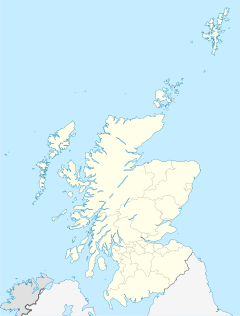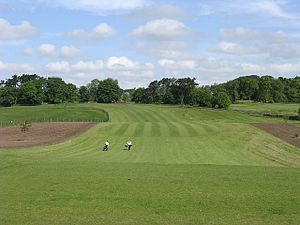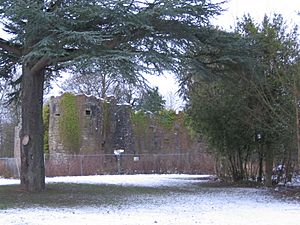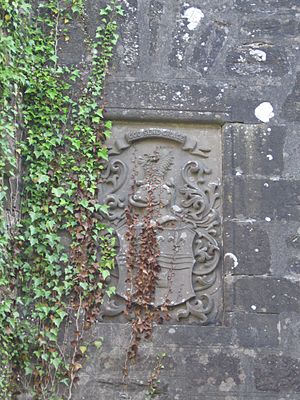Ballumbie facts for kids
Quick facts for kids Ballumbie |
|
|---|---|
| Council area | |
| Lieutenancy area | |
| Country | Scotland |
| Sovereign state | United Kingdom |
| Ambulance | Scottish |
| EU Parliament | Scotland |
Ballumbie is a residential area located on the north-east side of Dundee, Scotland. This area was once a large estate. It featured the historic Ballumbie Castle, built in the mid-1500s. Later, Ballumbie House was built in the 1800s. Today, Ballumbie also has a golf course. You can also find the site of an old medieval church there. The castle and house are just outside Dundee, in an area called Angus.
Contents
Ballumbie Castle: A Historic Fort
Ballumbie Castle was built by the Lovell family. It is a very old building with a rich history. Experts believe it was built around 1545. Some even think it might be older, from the 14th or 15th century.
The castle was a rectangular shape, about 21 meters (69 feet) on each side. It had round towers at its corners. From the castle, you could look out over the Fithie Burn, a small stream.
Castle Ownership and Changes
In the early 1600s, the Maule family took over the castle. They later became known as the Earls of Panmure. By 1682, the castle was already in ruins. However, parts of its old walls were used again. They became part of the stable building for Ballumbie House.
Today, Ballumbie Castle is a ruin once more. It is privately owned, so you cannot go inside. There is security fencing around it for safety reasons.
Ballumbie House: From Home to Flats
In 1810, Ballumbie House was built next to the old castle. It was built for a person named David Miller. This house was a two-story building in a classical style. It even had an ice house and stables. There was also a pond with flamingos! The house used some of the remaining parts of Ballumbie Castle in its structure.
House Remodeling and Fire
By 1902, a merchant named Alexander Gilroy owned the house. He hired an architect named James Findlay to make changes. The house was updated in a style called Arts and Crafts, mixed with Scottish Baronial.
Later, from 1965 to 1981, the house became a hotel. Sadly, a fire in 1982 badly damaged the building. For over twenty years, it was just an empty shell without a roof.
Modern Use of Ballumbie House
After many years, Ballumbie House was rebuilt. It was turned into modern flats. Around 230 new houses were also built in the surrounding grounds.
Ballumbie Parish Church: An Ancient Discovery
The Ballumbie parish church was first mentioned in records around 1470. It was last spoken of about 100 years later. For a long time, no one knew exactly where it was located.
Church Excavations
In 2006, a company called SUAT Ltd carried out excavations. This happened before new houses were built in the area. During their work, they found burials connected to a stone building. The excavation uncovered a simple rectangular stone building. It measured about 14 meters (46 feet) long and 4 meters (13 feet) wide. There were burials both inside the building and in a graveyard outside.
They also found a small chantry chapel or "laird's aisle." This chapel was about 4 meters (13 feet) square. It was attached to the south-east side of the church. These chapels allowed the laird (a Scottish landowner) and their family to be buried separately from other people. The Lovell family, who owned Ballumbie Castle, were likely the lairds at that time. Their old castle is about half a mile from where the church was found. They might have even founded the church.
Older Burials Found
The excavations also revealed something even older. They found a Christian long cist cemetery underneath the medieval church buildings. A cist is a stone-lined grave. This cemetery contained the remains of several adults and children.





